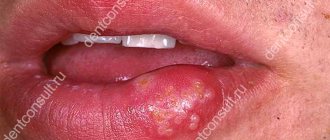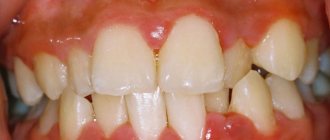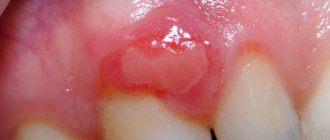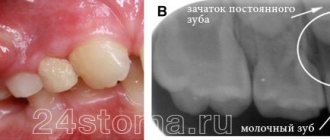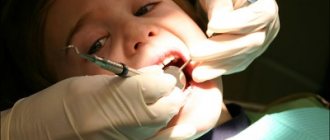Why do my gums bleed?
Bleeding from the gums can occur for mechanical or pathological reasons.
The first group includes a blow to the jaw area or minor injuries due to an incorrectly selected crown or filling. In this case, bleeding goes away immediately after the problem is eliminated. Only a doctor can assess whether a crown has been chosen correctly or a filling has been installed during a face-to-face consultation, because it is difficult to see such nuances on your own. Gums can also be damaged by a brush that is too hard, intensive use of dental floss, or careless impact with other objects in an attempt to completely remove food debris. In this case, bleeding appears only after the procedure and disappears after a few minutes.
Pathological causes are associated with diseases of the oral cavity and other organs. Bleeding is a symptom:
- gingivitis - inflammation of the gums;
- stomatitis - ulcers on the oral mucosa;
- periodontitis - inflammation of the soft tissues around the tooth (localized - in several units, or generalized with damage to the entire jaw);
- leukemia (leukemia) - blood cancer with a characteristic decrease in immunity;
- intoxication with heavy metals (lead, mercury);
- diabetes mellitus, which causes weakness of the gums and blood vessels due to characteristic angiopathy.
Often gums bleed due to hormonal changes. It can be caused by pregnancy, menstrual irregularities, and puberty.
When your gums bleed when brushing your teeth
Most patients' gums do not bleed constantly. Symptoms only appear when brushing your teeth or eating hard foods. This occurs for several reasons:
- inflammation of the gums makes them more vulnerable to injury;
- the process of desquamation of the epithelium of the oral mucosa intensifies, which thins the tissue;
- capillaries located close to the gums become more permeable and bleeding occurs more easily.
The combination of all three factors leads to the fact that when brushing your teeth, your gums begin to bleed. This symptom should not be ignored. Cure the disease at an early stage is much faster and cheaper than in an advanced form. And the appearance of blood when brushing your teeth is not considered normal; it is always a sign of pathology.
The appearance of a fistula due to unsatisfactory canal filling
Canal filling is a fairly common dental procedure indicated in the treatment of diseases such as periodontitis, pulpitis and in preparing teeth for subsequent prosthetics. However, in more than half of the cases, the canals are not filled as well as required by the rules. The most common mistake is filling not to the very top of the root.
Due to a mistake made by the doctor, an infection will form in the unsealed area of the canal over time, which sooner or later will go beyond the boundaries of the tooth and lead to inflammation. In addition to filling the entire length of the canal, the substance used to fill the canal during the procedure must be packed tightly: the appearance of voids and the formation of pores is unacceptable.
The main symptom indicating problems with the tooth is pain when biting. If you look carefully, in the immediate vicinity of the diseased tooth you can easily find a small hole through which pus will come out.
The appearance of a fistula on the gum, the treatment of which is not recommended to be delayed, indicates that the tooth will not stop hurting on its own. To treat it, the tooth is unfilled, an anti-inflammatory medicine is placed in the canals, which is removed after a certain period of time, and the canals are then filled again.
If a tooth has a crown or a pin, unfilling the canals becomes a real problem for the doctor. It is not always possible to remove the pin, and the crown will have to be re-installed after the procedure is completed, which is fraught with additional financial costs for the patient. Sometimes, if the canal is not sealed at its very end, the doctor decides to resort to a procedure for resection of the upper part of the root.
Resection is far from the most difficult operation: its duration is no more than an hour. The operation consists of several main stages:
- Preparation, during which the canals are carefully sealed a couple of days before the main procedure.
- Anesthesia. The operation is performed under local anesthesia: the patient does not feel pain during the doctor’s manipulations, but discomfort may occur later when the effect of the injection wears off.
- Gaining free access to the upper region of the root. To do this, the dentist cuts the gum, exposing the bone tissue, in which a hole is then cut using a drill.
- Through the resulting hole, the doctor cuts off the tip of the root, to which, as a rule, the cyst is attached, which causes inflammation.
- After removing part of the root, an empty cavity remains in the bone. The doctor can fill the space with synthetic tissue, which speeds up the growth process of natural bone.
- The final stage is suturing the gums. For intensive outflow of ichor, drainage can be installed for several days.
Predisposing factors
Bleeding gums can be caused by injury or disease. But there are a number of factors that make the risk of this symptom appearing higher.
Gums bleed in patients:
- with chronic inflammatory diseases of the oral cavity;
- with xerostomia - dry mouth;
- with reduced immunity, including HIV and AIDS;
- with vitamin deficiency, especially C and K;
- with mouth breathing;
- with poor or irregular oral hygiene.
These factors cannot be called the cause, but they contribute to the development of bleeding gums. Those for whom none of the points apply have a much greater chance of not learning about such a problem.
If your gums bleed in the morning or at night
Peak bleeding at night or in the morning indicates an unsuitable toothbrush. During brushing, the gums are injured. In this case, you need to visit the dentist and take a hygiene lesson with the selection of personal hygiene products.
Bleeding gums may not be normal. It is definitely worth finding out the cause and treating it before the disease reaches a chronic stage.
Bad breath due to bleeding gums
Bleeding from the gums is often accompanied by bad breath. There are several reasons for this:
- proliferation of bacteria against the background of inflammation;
- accumulation of soft and hard dental plaque;
- the presence of deposits under the gum that are not visible to the naked eye.
An unpleasant odor is a formidable symptom, since it does not appear immediately. This means the disease is already progressing. It is impossible to find out the cause and eliminate it on your own (without a dentist); The pathology will become chronic and it will be more difficult to cure.
A lump with pus on the gum against the background of bleeding
The appearance of a tumor on the gum can frighten anyone. The presence of a round swelling against the background of bleeding gums indicates one of the diseases:
- periodontitis - destruction of the soft tissue around the tooth with the formation of a characteristic lump;
- periodontitis - the presence of a capsule with pus on the gum due to destruction of the tooth root;
- intragingival fistula - a lump with pus inside, the contents of which, when ruptured, come out, significantly facilitating the patient’s well-being;
- periostitis (flux) - a red spherical formation on the gum, the appearance of which is accompanied by swelling of the cheeks and enlargement of the nearest lymph nodes;
- epulis is a neoplasm that does not contain pus, resulting from mechanical damage to the soft tissues of the oral cavity;
- Gingivitis is a painless lump on the gum.
Most of these conditions require urgent medical attention. If pus gets into the bloodstream or into the internal tissues of the tooth, it not only leads to severe pain, but also poses a fatal danger. If a lump appears on your gum, you should immediately go to see a dental surgeon. He will determine the cause of its formation and select treatment.
INSTALLING THE CROWN
If the crack is long or deep but does not reach the root of the tooth or extend below the gum line, a crown may be preferable to a crown instead of a build-up. Crowns are usually made of porcelain and serve as a covering for a damaged tooth, allowing it to be restored or even improved in shape. Your dentist may recommend a crown on your front tooth if the damaged tooth is not suitable for a crown. You'll need to spend a little more time in the dentist's chair waiting for the crown to be permanently secured to your cracked front tooth, and likely make several additional visits to your dentist. However, since a crown is more durable than extensions, with proper care you can expect it to last longer.
Gums bleed in pregnant women
While carrying a child, a woman’s body undergoes restructuring: special hormones begin to be produced, and the body changes. This also applies to the oral cavity. Every second pregnant woman is diagnosed with hypertrophic gingivitis. It is manifested by an increase in gingival papillae and the appearance of bleeding.
The cause of this condition in a pregnant woman can also be the accumulation of bacteria due to an increase in the depth of the gum pockets. Bacteria accumulate in them, causing inflammation. Proper brushing helps to avoid the development of bleeding gums. It is better to use an irrigator and mouth rinses for this.
Children's gums bleed
Young children enjoy brushing their teeth the least. If parents do not control the quality of oral hygiene, gingivitis occurs. In this case, the main symptom of the disease is bleeding gums.
The physiological cause of this condition in children is the process of teething. In this case, the integrity of the gum is compromised and it can bleed.
Problems with the gums are also caused by an incorrect bite. In this case, soft tissues are injured by teeth that are incorrectly positioned relative to each other.
Wearing orthodontic appliances can damage the integrity of the gums. This especially happens when wearing braces with uneven edges. To prevent injury, locks must be treated with special wax. But children often forget to do this; as a result, braces damage soft tissues, causing bleeding.
“Disease of dirty hands” - stomatitis, also more often affects children. They take less care of hygiene, which provokes the appearance of characteristic ulcers on the mucous membrane.
Some parents believe that children do not need to treat their baby teeth, because they will still be replaced by molars. This opinion is erroneous, because caries is caused by bacteria, and their constant presence in the mouth leads to periodontitis. The disease is characterized not only by bleeding gums, but also by the appearance of bumps with pus. This condition requires immediate medical intervention, otherwise serious complications arise.
Fistula on the gum: causes
A fistula on the gum is a hole that forms as a complication after inflammatory pathologies, including untreated ones. It can also occur after dental intervention (poorly provided services). Very often, a fistula is formed as a complication of long-term chronic periodontitis.
Also, the reasons for its appearance may be:
- damage to the tooth root;
- advanced caries;
- pulpitis;
- inflammatory processes of the cyst;
- problems with the growth of wisdom teeth;
- improper teething in children;
- granuloma - inflammatory processes in the tissues of the periosteum and the apical region of the tooth root (accompanied by an increase in temperature, enlarged lymph nodes and other signs).
Which doctor will help if my gums are bleeding?
If you have bleeding gums, you should consult a dentist. In the absence of complications, the doctor’s specialization does not play a role.
If the condition is complicated by the appearance of a lump with pus, you should immediately go to a dental surgeon. He will determine the type of tumor, choose treatment tactics and, if necessary, perform urgent surgery. At the Matisse Dent clinic, you don’t need to make an appointment several weeks in advance, endure pain and wait for help. With an acute condition, doctors will accept and perform surgery on the day of treatment.
SOS remedies against bleeding gums
Sometimes it’s impossible to get to the doctor and you need to wait 1-2 days until the appointment. In this case, several SOS tools will help.
- Rinses: chlorhexidine, oak bark decoction, LACALUT Aktiv rinses with aluminum lactate and sodium fluoride, PRESIDENT Antibacterial with plant extracts - relieve inflammation, prevent bleeding.
- Gels: Cholisal, Parodontocid - reduce pain, remove signs of inflammation.
- Pastes: Forest balm - contains oak bark, stops bleeding, strengthens gums.
All means must be used comprehensively. First, brush your teeth, then rinse (1 minute). After this, the solution is spat out and the gums are dried with gauze: this way the gel is better fixed. Then use ointments, applying with your finger to the entire inflamed surface. If saliva comes out during treatment, you should not swallow it, you need to spit it out.
After the procedure, you should refrain from drinking for 30 minutes and from eating for 2 hours. Treatment is carried out twice a day: after breakfast and at night.
The most effective remedy for diseases in which the gums begin to bleed is antibiotics. They help to quickly relieve inflammation and improve well-being. But they are available with a prescription and are taken only as prescribed by a doctor. Therefore, you won’t be able to buy and prescribe antibiotics yourself. It is better to immediately make an appointment with a specialist so as not to waste time and money on something that will not solve the problem, but will only delay the inevitable.
Main symptoms of fistula
Before the formation of a fistula, the tooth begins to hurt: when pressing on it and the surrounding area, painful sensations arise, it seems that the tooth is bursting from the inside.
Body temperature may rise and the gums may swell. When the pus comes out, the patient feels relief, thinking that the attack is over. However, this is a misconception: the disease continues to develop, although at this time the person feels much better. The tooth stops hurting, and pus no longer forms.
If no action is taken, the damage will affect the bone tissue, which will require more complex and lengthy treatment.
Mistakes in self-medication
When trying to get rid of bleeding gums on their own, patients make a number of mistakes. Never worth it:
- start taking antibiotics without a prescription - they may not be needed, but the blow to the body will be dealt;
- Stop brushing your teeth - this will only lead to a worsening of the condition;
- getting too carried away with oral hygiene - this will not save you from complications and will not cure, but will only aggravate the situation due to systematic injury to soft tissues;
- be afraid to go to the dentist - modern treatment methods are painless and do not cause discomfort, unlike purulent complications.
Lack of timely and competent treatment of bleeding gums leads to the spread of inflammation to bone formations. As a result, teeth become loose and fall out, requiring implants to be inserted. This is much more expensive than contacting a specialist in time to solve a gum problem.
You should not let the disease progress and self-medicate; come to the Matisse Dent clinic and receive competent medical care.
Fistula due to root perforation
Working with canals requires the dentist to be careful, attentive, and precise, controlled movements. The slightest carelessness can lead to the formation of a non-physiological hole (perforation), which will subsequently cause inflammation and, as a consequence, the appearance of a fistula.
A common mistake that leads to perforation and inflammation is the fixation of the pin when it is installed not along the canal, but its removal into the bone tissue.
With perforation, treatment of the fistula is the most problematic of all cases of its formation. Moreover, the main difficulty is not in medical procedures, but in the behavior of dentists who do not inform patients about the complication that has arisen, so as not to question the professionalism of themselves and their colleagues. As a result, a person who goes to the hospital for dental treatment returns again due to pain and inflammation: often the process becomes so advanced that it is no longer possible to do anything other than remove the tooth.
But still, perforation is not a death sentence, and the tooth can be saved. The sooner the patient applies, the greater the chance that the treatment will be completed successfully. True, this requires expensive materials (Pro Root MTA is often used), with the help of which the perforation area is sealed. Sometimes filling is performed directly through the canals, sometimes a surgical incision is required to gain visual access to the damaged area.



